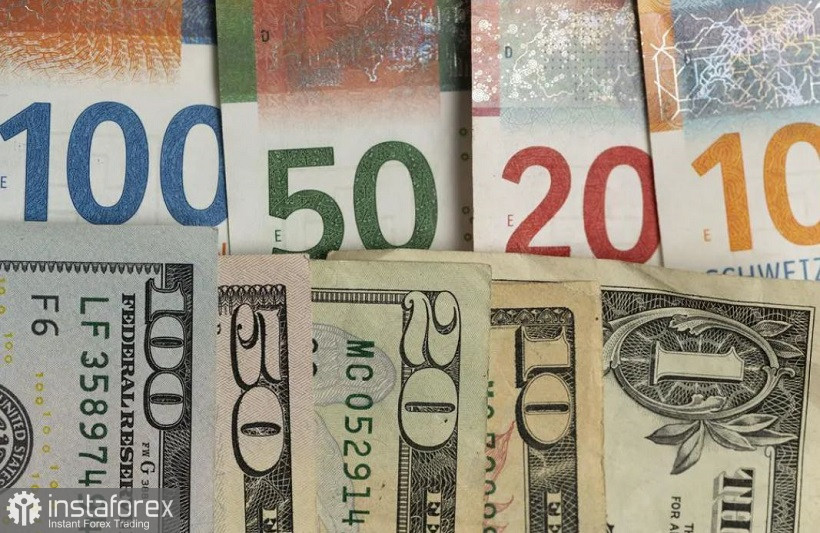The euro-dollar pair ended the trading week in the area of the 7th figure, at 1.0792. It is noteworthy that last Friday the price was in the same price area, ending the five-day trading period at the base of the eighth price level. That is, in fact, traders have not been able to significantly change the situation in a week – neither in favor of the upside nor in favor of the downside. After making a circle, the pair returned to their original positions. At the same time, bearish sentiment prevails for the pair: over the past three weeks, EUR/USD bulls have repeatedly tried to develop a corrective movement, but each time they returned back to the base of the 8th figure. The upward momentum fades away in the price area of 1.0930-1.0950, after which the price rolls down. The bulls fail to turn the situation in their favor: situational successes are mainly due to the temporary weakening of the dollar. The European currency is still under strong pressure.

However, last week the euro still saw the "light at the end of the tunnel", though not for long. On Wednesday evening, it was reported that two European Central Bank representatives – Luis de Guindos and Martins Kazaks – announced that interest rates could be raised at the July meeting. Against the background of disappointing and vague results of the ECB's April meeting, this plot twist surprised many traders. The EUR/USD pair jumped to 1.0935 – and this is a rare case when the price increase was due to the strengthening of the euro. But literally the next day, that is, on Thursday, ECB President Christine Lagarde returned the bulls "from heaven to earth": according to her, the ECB's monetary policy "will depend on incoming data and an assessment of the prospects." At the same time, Lagarde acknowledged that downside risks for the European economy have increased, while the acceleration of inflation is mainly caused by rising energy prices. That is, the head of the ECB again hinted at the temporary nature of inflationary growth, adding that the prospects for the growth of core inflation "are not completely clear." The market reaction was not long in coming: the EUR/USD pair turned 180 degrees and fell by more than 100 points.
Against the background of the ECB's general indecision, the US central bank continues to voice opposite messages. On the eve of the 10-day "silence on the air" (when Federal Reserve representatives do not have the right to publicly announce their position), Fed Chairman Jerome Powell made a fairly clear hawkish message. He not only supported the idea of a 50-point rate hike at the May meeting, but also allowed a more aggressive pace of monetary policy tightening in the future. Many experts interpreted Powell's rhetoric very unambiguously – as a hint of a 50-point rate increase in June. Against the background of such prospects, American stocks suffered losses, the US dollar index again crossed the 101-point mark, and the yield of 10-year treasuries reached 2.940% (a 3.5-year high). The euro-dollar pair, respectively, again approached the support level of 1.0750, which corresponds to the lower line of the Bollinger Bands indicator on the D1 timeframe.
The geopolitical background also contributes to the strengthening of the US currency. Negotiations between Russia and Ukraine have finally stalled: the head of the Russian Foreign Ministry, Sergey Lavrov, yesterday once again focused his attention on this. He suggested that the Ukrainian side, judging by its statements, negotiations are no longer needed. And although the de jure negotiation process continues, de facto it stands still. According to media reports, the parties cannot find a common denominator on several points of the agreement in order to reach the finish line and outline at least approximate dates of the face-to-face meeting. The optimism associated with the results of the "Istanbul meeting" has long dried up, while there are no new reasons for any optimism yet. Therefore, the dollar is in high demand, including due to the strengthening of anti-risk sentiment. The euro, in turn, has to be "content" with the reverse side of the coin of the current situation. These are the risks of stagflation, the impending energy crisis, and the "echoes" of the sanctions confrontation. Therefore, geopolitics in this case is completely on the side of the greenback – EUR/USD bears are the beneficiaries of the current situation.
Nevertheless, despite the dominance of the US currency, the bears have not yet managed to overcome the support level of 1.0750 (the lower line of the Bollinger Bands on the daily chart). As soon as the price approached this price barrier, traders took profits, thereby extinguishing the downward momentum. Therefore, taking into account the prevailing fundamental background, it is advisable to use corrective pullbacks of the pair to open short positions with 1.0750 as the target. To overcome this price threshold, EUR/USD bears need a powerful informational momentum that will allow them to decline to the base of the 7th figure.





















